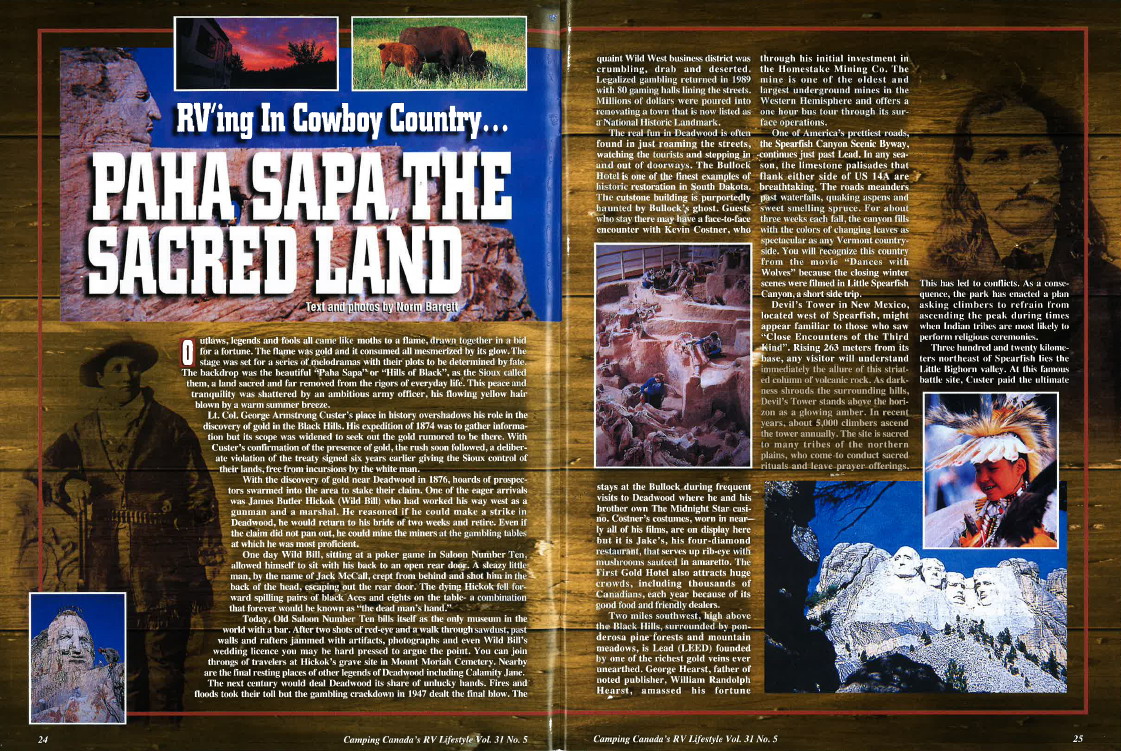From the archives:
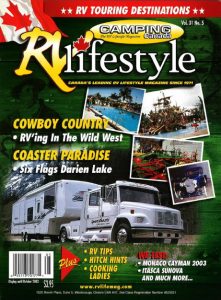 Paha Sapa, The Sacred Land
Paha Sapa, The Sacred Land
by Norm Barrett
This travel feature appeared in
RV Lifestyle Magazine,
Volume 31, Number 5, May 2002
Outlaws, legends and fools all came like moths to a flame, drawn together in a bid for a fortune. The flame was gold and it consumed all mesmerized by its glow. The stage was set for a series of melodramas with their plots to be determined by fate. The backdrop was the beautiful “Paha Sapa” or “Hills of Black”, as the Sioux called them, a land sacred and far removed from the rigors of everyday life. This peace and tranquility was shattered by an ambitious army officer, his flowing yellow hair blown by a warm summer breeze.
 Lt. Col. George Armstrong Custer’s place in history overshadows his role in the discovery of gold in the Black Hills. His expedition of 1874 was to gather information but its scope was widened to seek out the gold rumored to be there. With Custer’s confirmation of the presence of gold, the rush soon followed, a deliberate violation of the treaty signed six years earlier giving the Sioux control of their lands, free from incursions by the white man.
Lt. Col. George Armstrong Custer’s place in history overshadows his role in the discovery of gold in the Black Hills. His expedition of 1874 was to gather information but its scope was widened to seek out the gold rumored to be there. With Custer’s confirmation of the presence of gold, the rush soon followed, a deliberate violation of the treaty signed six years earlier giving the Sioux control of their lands, free from incursions by the white man.
With the discovery of gold near Deadwood in 1876, hoards of prospectors swarmed into the area to stake their claim. One of the eager arrivals was James Butler Hickok (Wild Bill) who had worked his way west as a gunman and a marshal. He reasoned if he could make a strike in Deadwood, he would return to his bride of two weeks and retire. Even if the claim did not pan out, he could mine the miners at the gambling tables at which he was most proficient.
One day Wild Bill, sitting at a poker game in Saloon Number Ten, allowed himself to sit with his back to an open rear door. A sleazy little man, by the name of Jack McCall, crept from behind and shot him in the back of the head, escaping out the rear door. The dying Hickok fell forward spilling pairs of black Aces and eights on the table- a combination that forever would be known as “the dead man’s hand.”
 Today, Old Saloon Number Ten bills itself as the only museum in the world with a bar. After two shots of red-eye and a walk through sawdust, past walls and rafters jammed with artifacts, photographs and even Wild Bill’s wedding licence you may be hard pressed to argue the point. You can join throngs of travellers at Hickok’s grave site in Mount Moriah Cemetery. Nearby are the final resting places of other legends of Deadwood including Calamity Jane. The next century would deal Deadwood its share of unlucky hands. Fires and floods took their toll but the gambling crackdown in 1947 dealt the final blow. The quaint Wild West business district was crumbling, drab and deserted. Legalized gambling returned in 1989 with 80 gaming halls lining the streets. Millions of dollars were poured into renovating a town that is now listed as a National Historic Landmark.
Today, Old Saloon Number Ten bills itself as the only museum in the world with a bar. After two shots of red-eye and a walk through sawdust, past walls and rafters jammed with artifacts, photographs and even Wild Bill’s wedding licence you may be hard pressed to argue the point. You can join throngs of travellers at Hickok’s grave site in Mount Moriah Cemetery. Nearby are the final resting places of other legends of Deadwood including Calamity Jane. The next century would deal Deadwood its share of unlucky hands. Fires and floods took their toll but the gambling crackdown in 1947 dealt the final blow. The quaint Wild West business district was crumbling, drab and deserted. Legalized gambling returned in 1989 with 80 gaming halls lining the streets. Millions of dollars were poured into renovating a town that is now listed as a National Historic Landmark.
The real fun in Deadwood is often found in just roaming the streets, watching the tourists and stepping in and out of doorways. The Bullock Hotel is one of the finest examples of historic restoration in South Dakota. The cutstone building is purportedly haunted by Bullock’s ghost. Guests who stay there may have a face-to-face encounter with Kevin Costner, who stays at the Bullock during frequent visits to Deadwood where he and his brother own The Midnight Star casino. Costner’s costumes, worn in nearly all of his films, are on display here but it is Jake’s, his four-diamond restaurant, that serves up rib-eye with mushrooms sauteed in amaretto. The First Gold Hotel also attracts huge crowds, including thousands of Canadians, each year because of its good food and friendly dealers.
Two miles southwest, high above the Black Hills, surrounded by ponderosa pine forests and mountain meadows, is Lead (LEED) founded one of the richest gold veins ever unearthed. George Hearst, father of noted publisher, William Randolph Hearst, amassed his fortune through his initial investment in the Homestake Mining Company. The mine is one of the oldest and largest underground mines in the Western Hemisphere and offers a one-hour bus tour through its surface operations.
One of America’s prettiest roads, the Spearfish Canyon Scenic Byway, continues just past Lead. In any season, the limestone palisades that flank either side of US 14A are breathtaking. The road meanders past waterfalls, quaking aspens and sweet smelling spruce. For about three weeks each fall, the canyon fills with the colours of changing leaves as spectacular as any Vermont countryside. You will recognize this country from the movie “Dances with Wolves” because the closing winter scenes were filmed in Little Spearfish Canyon, a short side trip.
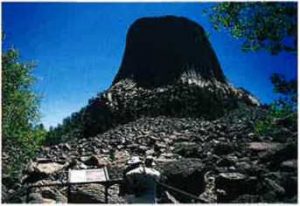
Devil’s Tower in New Mexico, located west of Spearfish, might appear familiar to those who saw “Close Encounters of the Third Kind”. Rising 263 meters from its base, any visitor will understand immediately the allure of this striated column of volcanic rock. As darkness shrouds the surrounding hills, Devil’s Tower stands above the horizon as a glowing amber. In recent years, about 5,000 climbers ascend I the tower annually. The site is sacred to many tribes of the northern plains, who come to conduct sacred rituals and leave prayer offerings.
This has led to conflicts. As a consequence, the park has enacted a plan asking climbers to refrain from ascending the peak during times when Indian tribes are most likely to perform religious ceremonies.
Three hundred and twenty kilometers northeast of Spearfish lies the Little Bighorn valley. At this famous battle site, Custer paid the ultimate price for violating the sacred grounds of the Sioux. Disobeying orders, he attacked a large Indian camp. Severely underestimating the strength of his adversary, he found himself pinned down by some 4,000 warriors. Out of the ashes of his demise arose two Native Americans, Sitting Bull and Crazy Horse, who would become icons to their followers.
Sitting Bull, North America’s most famous medicine man and Indian leader, always impressed his warriors with his bravery and the strength of his visions. Even though he was credited with masterminding the Indian strategy, he did not have a major role in leading the battle, a distinction that would go to Crazy Horse. Emboldened by a previous victory, Crazy Horse moved north and joined Sitting Bull. In the battle, Crazy Horse attacked Custer from several fronts and eventually outflanked Custer by seizing the high ground thus ending Custer’s last hope of establishing a defensive position. After the battle, Sitting Bull fled temporarily to Canada while Crazy Horse continued to wage a brilliant campaign.
The victories would be bittersweet. Both men predicted their deaths by the hands of their own people. Sitting Bull was shot twice in the back by the Sioux tribal police while Crazy Horse, his arms held by Little Big Man, was bayoneted by a white army private. In 1953,Sitting Bull’s descendants removed his remains to a high bluff outside of Mobridge, South Dakota, close to his home grounds. Nobody knows exactly where Crazy Horse is buried but legend has it near the creek called Wounded Knee. Even in death, Sitting Bull and Crazy Horse remain controversial, mysterious and a continuing remainder of Native Americans proud struggle for independence.
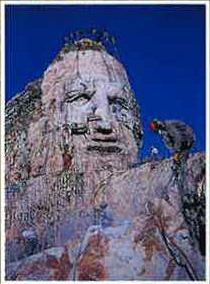
Crazy Horse, dead more than one hundred and twenty-five years, buried no one knows where, is rising again over the Black Hills just eight kilometers north of Custer. It seems ironic that someday he will dominate over the little town named after his arch nemesis. Today, as in life, his horse is with him.
The idea to create the Crazy Horse memorial began in 1939 when Korczak Ziolkowski, an assistant to the great sculptor of Mt. Rushmore, received a letter from Chief Standing Bear stating that the Sioux, “would like the white man to know the red man has great heroes too”. Seven years later, Korczak agreed to nudge the man and his horse out of what was once Thunderhead Mountain. The largest sculpture in the world, depicting the chief on horseback, will someday be 194 meters long and 171 meters high. One day his arm will stretch out almost the length of a football field.
After Korczak’s death, his wife and children continued on his work. They began the carving of the face rather than the head of the stallion which Korczak had envisioned completing first. The head was just completed last year. The carving is best seen each evening when it is illuminated for one hour. Visitors can also tour the sculptor’s studio home as well as the Indian Museum of North America which is home to one of the most extensive collections of Plains Indian artifacts in the country.
The town of Custer is surrounded by the Custer State Park said to have the largest and most diverse population of wildlife and the most spectacular natural resources of any park in the state. Here, more than 1,500 bison roam free on the 73,0000 acre preserve. “Buffalo jams” are more common than bumper-to-bumper traffic. Although wildlife sightings are not a certainty, visitors are likely to meet the park’s resident “begging burros”, descendants of those used to carry travelers up to Harney Peak. Stock up on healthy handouts before entering the park as these “toll collectors” will deposit slippery saliva on your windows as a sign of their displeasure.
Several scenic drives traverse the park. The 29 km Wildlife Loop circles grasslands and pine studded hills home to more than a thousand bison. The Needles Highway (SR87) takes motorists on a 22 km adventure past tall granite spires to the highest reaches of the park. Vehicles have to negotiate several hairpin turns and squeeze through narrow tunnels. Those with large trailers or motorhomes should use extreme caution. Among the special spots on the route are the Needle Eye and the Cathedral Spires, unique formations of granite towers. The Needles Highway ends at its northern terminus into Sylvan Lake, famous for its scenic setting. The small 18 acre lake is surrounded by mammoth rock formations rising from the water’s edge. Sylvan Lake offers one of the best campgrounds in the state to settle down for an evening or two. Have a cocktail on the veranda of the lodge, ponder the events of the day and admire the splendid view of Mt. Harney.
Sharing the southern boundary of Custer State Park, Wind Cave National Park with its 114 km of mapped passageways, ranks as the seventh longest cave in the world. Wind Cave is part of a great cave system that lies beneath the Black Hills. A system some scientists believe has been only five percent mapped. At Wind Cave and at nearby Jewel Cave National Monument, a maze of rare and unusual boxwork, frostwork and popcorn formations awaits those with enough nerve to travel underground. Park rangers conduct underground tours ranging from the standard sightseeing to spelunking and candlelight expeditions.
Just 20 km south of Wind Cave, the Mammoth Site in Hot Springs has one of the largest concentrations of Columbia mammoth bones found to date. Fifty-two mammoths along with twenty-seven other species of Ice Age animals apparently died in this ancient spring fed sinkhole. A superb building covers the site. Guided tours explain the site’s histoiy and current excavations can be viewed. The Mammoth Site ranks with Mount Rushmore, Crazy Horse and Deadwood as the four most worthwhile destinations in South Dakota.
Immediately southwest of Keystone on US 16A is the Iron Mountain Road, brainchild of US Senator Peter Norbeck. Norbeck personally laid out the entire route much to the disappointment of the road builders that followed. What he wrought is still visible today in a roadway that is both a wonder of engineering and a motorhome driver’s nightmare. As you drive through three of the narrow tunnels, you have perfectly framed views of Mt. Rushmore.
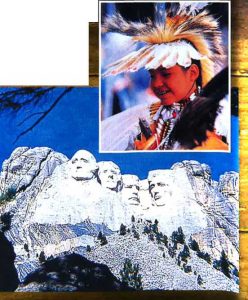
Mt. Rushmore grew from the concept of Peter Norbeck to the reality created by Gutzon Borglum. Borglum arrived in the Black Hills in the summer of 1925 at the invitation of Senator Norbeck to do an enormous sculpture of the Old West’s legendary heroes. Borglum surprised everyone by announcing that the subjects of the sculpture would be national, rather than Western, figures. The four American presidents were chosen to represent the birth, growth, preservation and development of the nation.
For the next fourteen years, Borglum and his crew drilled, blasted and chiselled the face of Mt. Rushmore into the images of the four presidents to become one of the largest pieces of sculpture ever created. The sculptor carved away twice the rock needed to construct Egypt’s Great Sphinx. Each face is more than 18 meters long and carved with an intricate perfection of detail and expression.
The best time to see Mt. Rushmore is in the early morning hours when sunlight from the east casts a warm glow on it. It is also lit with artificial light at night from 9:30 P to 10:30 P. Almost three million visitors flock to the memorial each year making it one of the most popular national parks and especially congested during the summer months when visitors cue up for the evening viewing. It is recommended to leave trailers at nearby campgrounds and motor homes at the free remote parking area due to the shortage of daytime parking and a very steep road grade.
A short walk from the free parking area leads to Borglum’s studio where his original models of the four presidents are displayed. Visitors can also view the tools used during the construction. From the studio, the recently completed Presidential Trail winds its way to the base of the monument affording the closest viewpoints. The trail will bring you back to the state-of-the-art Visitor Center and Museum and a brief orientation film. Of course the tour can be done in reverse order for those who choose to enter at the main entrance.
In nearby Hill City, the 1880’s Train will huff and puff for every railroad buff. The scream of its steam whistle punctuates the quiet as one of America’s last steam trains still in service makes the two hour round trip to Keystone. This is the same route used by miners and pioneers to explore the Black Hills. Along the way, locations used in the filming of “Gunsmoke” , as well as many other Western films, can be seen. Matt Dillon has even blown the trains whistle!
On the subject of whistle, you can wet yours at the Flying T Chuckwagon Supper located on US 16, south of Rapid City. The dinner bell rings at 6:30P nightly for a hearty chuckwagon dinner. Then it is time for a foot-stomping show with twin fiddles and the funniest comedy in the Black Hills. An evening tour package is offered by Gray Line which includes the cowboy supper, show and the impressive night lighting of Mt. Rushmore.
State Hwy. 44 East from Rapid City (the road less traveled) follows the Rapid Creek through rolling grasslands which abruptly give way to chiseled spires, ragged ridges and deep canyons – the setting for the Badlands, the strangest area in the state. So stark is Badlands National Park that it has been described as “hell with the fires burned out”. The Sioux and the French fur traders of the 1800’s, each in their own language, named this forbidding region the “bad lands”. In this land so ruthlessly ravaged over the ages by the wind and rain, the raw elements are a powerful reminder of the forces of nature.
Some 6 km south of the town of Scenic on County Hwy. 589, the more adventurous will want to admire the spectacular views from the top of Sheep Mountain Table. The rough road to the top of the plateau is impassable when wet. Near Scenic, County Hwy. 590 travels north until it becomes the Sage Creek Rim Road leading you right into the midst of the biggest prairie dog town you have ever seen. In the basins, you can also usually spot some bison. Late afternoon colors, struck by the low-angled sun-, brighten the panorama like daubs on an artist’s palette rose and tan, purple and slate.
The Sage Creek Rim Road ends at the Badlands Loop Road which provides several panoramic overlooks. The short nature trails throughout the park really let one savor this desolate land. Despite its apparent inhospitable landscape, the park is still convenient to visit. The Visitor Center at Cedar Pass is the key contact point, featuring an information center, an AV program and a fossil exhibit.
In 1935, Frank Lloyd Wright traveled through South Dakota and was greatly moved by the unique landscape of the Badlands. In his letter to Robert D. Lusk, he stated, “What I saw gave me an indescribable sense of mysterious otherwhere- a distant architecture, ethereal, touched, only touched with a sense of Egyptian, Mayan drift and silhouette.” As the setting sun plays on the imagination, silhouettes are formed out of nature’s creations – Crazy Horse, Wild Bill and Sitting Bull – staring up at the heavens as the curtain falls on their moment in history.
Few of the thousands of tourists who visit Deadwood each year and stand around the grave of Wild Bill really appreciate the part that he and his contemporaries played in winning the West. Each in his own way contributed to the expansion of the United States. It was this expansionism, fuelled by gold fever, that robbed the Plains Indians of their sacred lands. Their leaders were left with the choice of defending a way of life from encroachment of the white man or perish.
Even with their tragic deaths, their memories live with us today. At Sitting Bull’s grave, his seven-ton granite bust, by sculptor Korczak Ziolkowski, looks out over a horseshoe bend in the Missouri River valley where the chief once roamed. This somewhat desolate memorial nonetheless carries the resiliency, the intelligence and the quiet pride of a great Sioux leader.
It has been said that Crazy Horse during his life never owned a very good horse. But he has a powerful horse now, a horse as strong as a mountain. If the Ziolkowski family can only keep it up, he will finally rise forever over the Black Hills – in spirit at least. He will have managed to take back the road General Custer opened: the road the Sioux call the Thieves Road. ♦
CAMPGROUNDS
SOUTH DAKOTA CAMPGROUND -GUIDE- https://www.travelsouthdakota.com/things-to-do/outdoor-activities/camping/great-places-great-wide-open?utm_actcampaign=62980&gclid=Cj0KCQjwtrSLBhCLARIsACh6RmilSv5VjuwlAuPg3YgWidR5376pJc30VB7JDQP10-N98exFtsP-EQQaAvBeEALw_wcB
HOTSPRINGS KOA (800) 732-5682, PO Box 149A Hot Springs, SD 57747
South Dakota State Parks Camping Reservations (605) 745-429I* (800) 710-2267 www.campsd.com
CUSTER STATE PARK (SYLVAN AND GAME LODGE CAMPGROUNDS) HC 83, Box 700 Custer, SD 57730 (605) 255-4515 . www.state.sd.us/sdparks
SPEARFISH CITY CAMPGROUND 625 Fifth St. Spearfish, SD 57783 (605)642-1340
WHISTLER GULCH RV PARK Hwy. 85 South, 235 Cliff St. Deadwood, SD 57732 (800) 704-7139
MYSTERY MOUNTAIN RESORT 13752 S. Hwy. 16 Rapid City, 57702-9258 (800)658-2267 www.mmresort@rapidnet.com
BEAVER LAKE CAMPGROUND Rt.1, Box 55H Custer, SD 57730 (605) 673-2464


















